The Great Coffee Grinder Showdown: Burr vs Blade Grinders Compared
In this article, I’ll compare these two types of grinders so you can make an informed decision about which type to get. (Hint: burr 😉 )
Key Takeaways:
- Importance of Fresh Grinding: Grinding coffee beans just before brewing preserves flavor and aroma, countering the rapid flavor loss in ground coffee.
- Blade Grinders’ Downside: They create an inconsistent grind size, leading to uneven extraction and a less desirable cup of coffee.
- Burr Grinders’ Advantage: These grinders produce a consistent grind size, which is key for flavor extraction in coffee brewing.
- Manual vs Electric Options: Manual burr grinders offer control and are budget-friendly, ideal for small batches. Electric burr grinders provide convenience and speed, suitable for larger quantities and regular use.
- Overall Recommendation: Burr grinders are better than blade grinders for a more consistent and flavorful coffee experience, with the choice between manual and electric depending on personal brewing habits and quantity.
Blade coffee grinders – Should you try them?
A blade grinder is basically a mini food processor that chops the beans into small pieces using spinning blades. The longer you run it, the finer grind you’ll get.
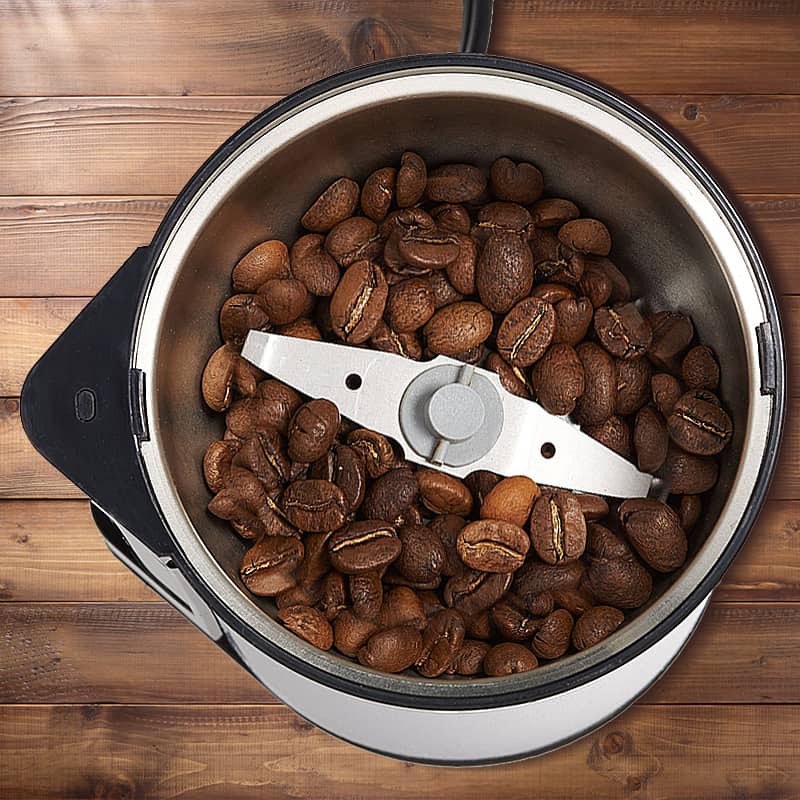
Pros
Cons
Blade grinders are fast and easy to use, but they don’t produce consistent results. There is no way to truly control the fineness of the grinding process other than pulsing the blades and randomly shaking the machine to mix the beans as you grind them.
This means that you will end up with some fine particles mixed in with larger ones – not ideal if you’re looking for uniformity in your cup of coffee (or espresso).
Check the image below, you’ll see that there are large and small particles mixed together.
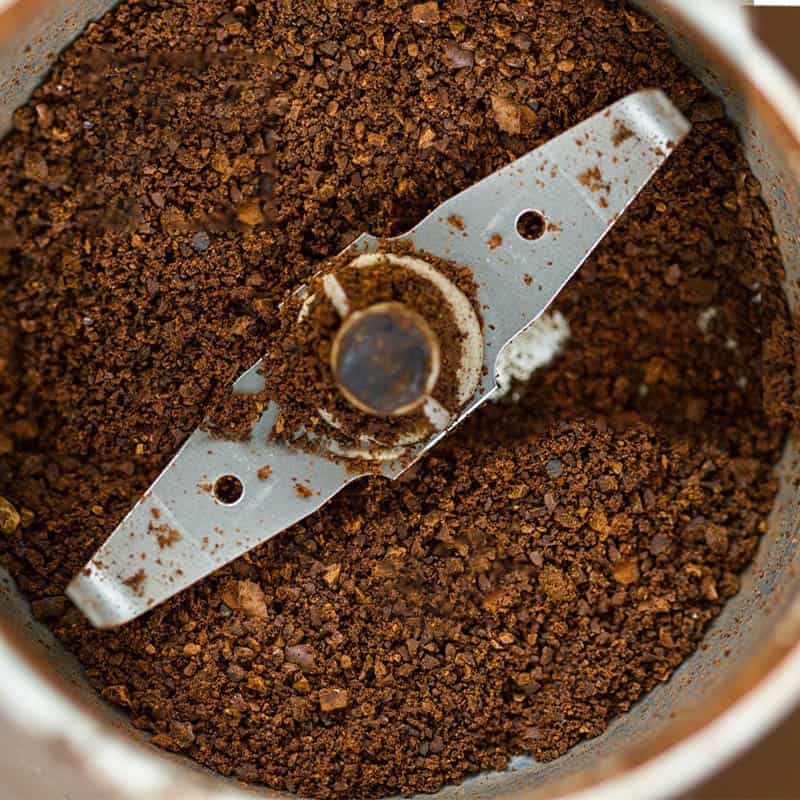
As you may (or may not) know, grind size consistency is vital in making a delicious cup of coffee (or espresso). That’s because different grind sizes will extract differently, resulting in varying degrees of flavor.
Just imagine what happens when you have finely ground AND coarsely ground coffee mixed in one brew. The finely ground particles extract almost immediately when they come into contact with hot water, while the larger ones take much longer. This would result in an uneven and inconsistent cup of coffee — yuck!
For this reason, I do not recommend using a blade grinder to grind your coffee beans.
Burr coffee grinders – How do they work?
A burr grinder, also known as a coffee mill, uses two grinding plates moving against each other to crush the beans and grind them into a consistent size.
The size of coffee grinds made by burr mills is as consistent as you can get, because the space between the burrs is always the same. Only particles under a specific size can fall down through the abrasive surfaces. This results in a more uniform grind, which is essential for making consistent cups of coffee.
There are 2 types of burr coffee grinders, which differ in the shape of their grinding plates:
- Flat plate burr grinders (below left) have two flat burrs (that look a bit like large coins) that sit on each other.
- Conical burr grinders (below right) have a conical-shaped plate that sits in a second, similar-shaped plate.
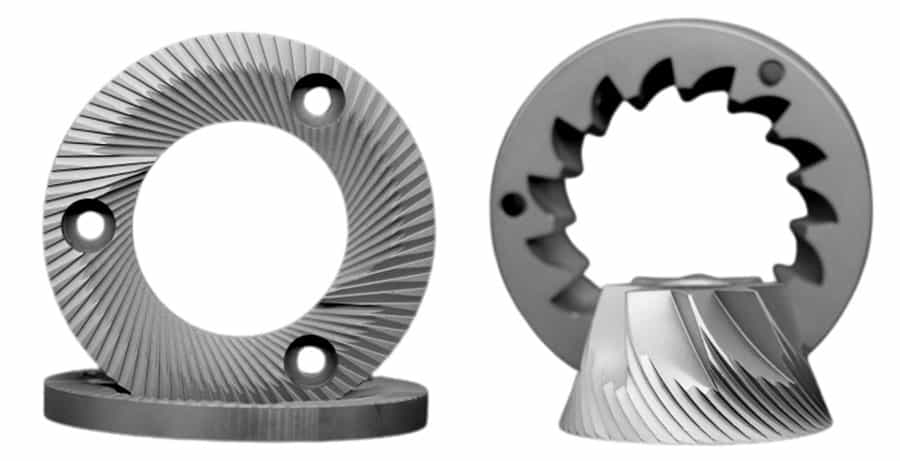
Flat burr grinders make even more consistent grounds, but heat up quicker and are more expensive. They are mostly used at coffee competitions. Conical burr grinders are slightly less consistent, but they are the industry standard in cafés and the homes of coffee aficionados.
The burrs are made of either ceramic or stainless steel. Ceramic burrs cost more and usually last longer, but are damaged more easily. I prefer steel conical burrs.
Manual burr coffee grinders are great for home use
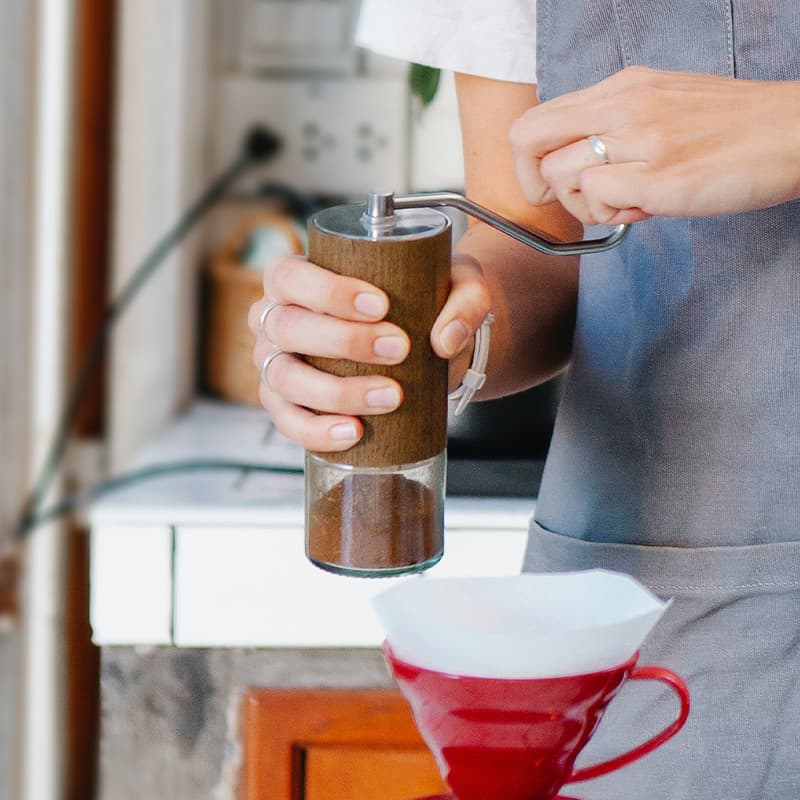
Pros
Cons
Manual burr grinders are manually operated and require the user to crank a handle to rotate the grinding plates. This type of grinder is ideal for people who want more control over their grind size, as well as for those who want a more traditional coffee-making experience. Plus, it’s an eco-friendly option if you prioritize sustainability in your daily cup.
You can set the coarseness of a manual burr grinder by turning the knob that controls how far the plates are apart. The further apart they are, the coarser the grind will be. Alternatively, if they’re close together, it’ll be finer.
Keep in mind that the finer the grind size, the harder it is to turn the crank and the longer it takes. For example, grinding 18g for a double espresso takes about a minute of cranking, and might even tire you out. There is substantial physical effort involved for fine grinds, but not for coarse grinds that you use for pour-over or French press.
Electric burr grinders are quick and easy
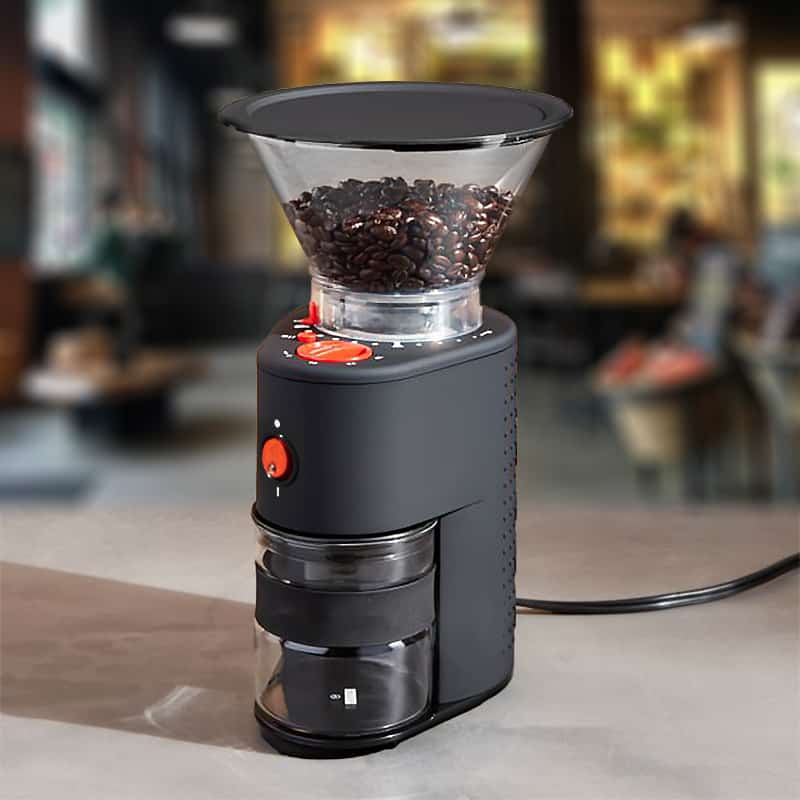
Pros
Cons
Electric burr coffee grinders do all the work for you — you load your beans into the hopper and press a button (or two). They have settings that allow you to choose how coarse or fine you want your coffee grounds to be.
These types of grinders tend to be more expensive than manual ones, but they’re also much faster and easier to use.
Should you get an electric or a manual burr grinder for home use?
I’ve written a detailed article on manual vs electric coffee grinders here if you are interested.
In short, these are the things you’ll need to think about to decide:
- The amount of coffee you typically make – If you’re only making 1 or 2 cups at a time, manual grinders are a great choice. They take a bit more time and effort to grind your coffee, but are dependable and less expensive.
- The brewing method you predominantly use – Grinding fine espresso coffee takes much longer than coarse coffee with a manual grinder and is much more labor intensive. Most women actually find grinding to espresso fineness very challenging on a manual coffee grinder. So if you make a lot of espresso, an electric grinder that can grind to a fine consistency is a better choice.
- If you’re looking for more of a traditional experience or want more control over your grind, then go with a manual model.
Blade vs. burr coffee grinder grinds compared
Now that you know how each type of grinder works, it’s time to compare them in writing and test them.
| Manual burr grinder | Electric burr grinder | Blade grinder | |
|---|---|---|---|
| Consistent grind size | Yes | Yes | No |
| Control over grind size | Full control | Full control | No control |
| Price | Mid to high | Mid to high | Low |
To show you how vastly different the grind consistency can be, I set out to compare burr & blade grinder coffee grinds.
I used my 1zpresso J-Max manual burr grinder and a no-name blade grinder, aiming to get a medium-fine consistency for my favorite Aeropress recipe (the brewing method I’ve been using the most in 2024).
The difference between the two types of grinders speaks for itself. Can you tell which batch is from the burr grinder, and which is from the blade grinder?
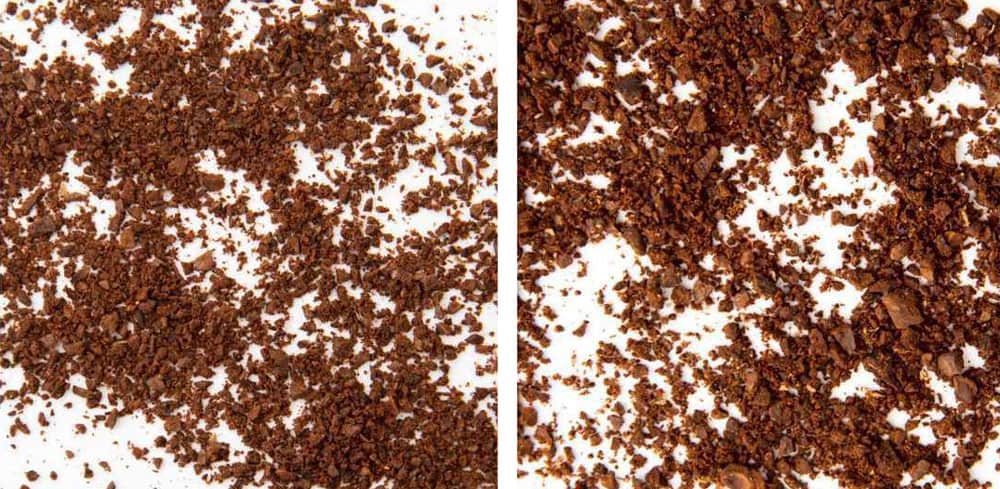
- The burr grinder (left) created a fairly uniform size grind with no large pieces.
- On the other hand, the blade grinder (right) produced coffee grounds ranging from dust to chunky bits – not ideal for making a consistent cup of coffee.
I brewed both to taste-test the blade vs. burr grinders.
The blade grinder coffee tasted weird. Bitter, since the smallest particles were over-extracted, but without body, since the larger particles were not fully extracted. What a waste of perfectly good coffee beans.
Summary
There are two types of coffee grinders in this world: burr and blade. And there is no mistaking which one is better!
Burr grinders pulverize the beans into uniform pieces, while blade grinders just hack them up into random shapes and sizes. That means that with a burr grinder, you’ll get uniform particle size, consistent extractions, and tastier coffee overall. Going for the best manual burr grinders out there (the Comandante MK4, 1Zpresso JX-Pro, Timemore C2 Max, and Timemore Slim Plus come to mind) also allows you better control over your grinds.
Plus, any coffee professional will tell you that it’s just more fun to use a machine that looks like it could double as a medieval torture device 😉






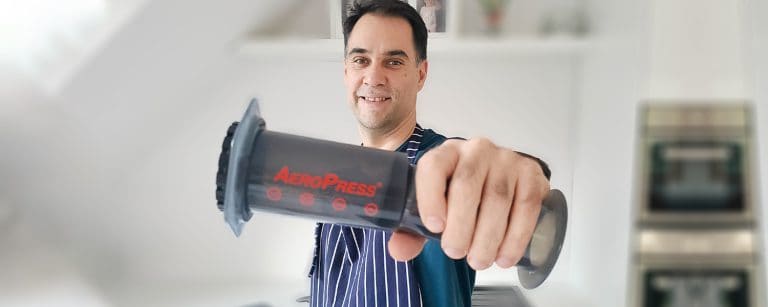


I would love to see a blind taste test to see if people can tell the difference between a burr grinder and a blade grinder. That would be interesting. Same beans, same machine etc.
That is a fantastic idea Paul! Home baristas can definitely tell, but seeing whether average coffee drinkers could as well, that would be very interesting.
I have to disagree with the blanket statement against blade grinders. While they’re not ideal, not everyone can afford a burr grinder. I’ve managed to get decent results from mine by using a pulsing technique. Just takes a bit of practice.
Yes, you can make coffee with it, but it will only be max decent, never great.
I absolutely love my electric burr grinder for busy mornings. Just a few seconds and I have the perfect grind for my French press. Couldn’t live without it now, thanks for confirming I made the right choice with this comprehensive article.
I feel like there’s a bit missing here about the heat generation in blade grinders. Could you clarify if this impacts the flavor of the coffee? I’ve heard that it can cause the beans to lose some of their nuanced tastes.
Blade grinders spin so fast that they heat up the coffee grinds, which is the reason they lose some of their taste. But as I mentioned in the article, blade grinders are not that great for grinding coffee…
I’ve always been a blade grinder person because I didn’t know any better, but this article really highlighted what I’m missing out on with a burr grinder. I’m thankful for making the differences clear. This might just be the push I need to upgrade.
Great comparison, but I’m curious – how often should I replace the burrs in my grinder? I’ve noticed the grind quality change over time, which affects my brew.
It depends on the material of the burrs and also the quality of the product, so it’s not that straightforward. But home used burr grinders are good for years. Maybe you need to clean them, coffee bean residue can definitely impact grind quality.
I’ve noticed that some electric burr grinders can be pretty loud. Can anyone recommend a model that balances quality grinding with quieter operation? Would love to hear personal experiences before making an investment.
Hi there, I make some recommendations here: https://bigcupofcoffee.com/best-electric-burr-coffee-grinders/
Does anyone else feel like the manual burr grinder process is a bit of a ritual? It takes longer, but I find it really therapeutic in the morning. Plus, the grind consistency is absolutely worth the extra effort.
This was such an informative read. I’m a bit of a coffee aficionado and I’m glad to see more people learning about the importance of grind consistency. Your summary of blade vs. burr grinders was spot on. Would love to see a deep dive into conical vs flat burr grinders next.
As luck would have it, I have an artile comparing flat vs conical burr grinders here.